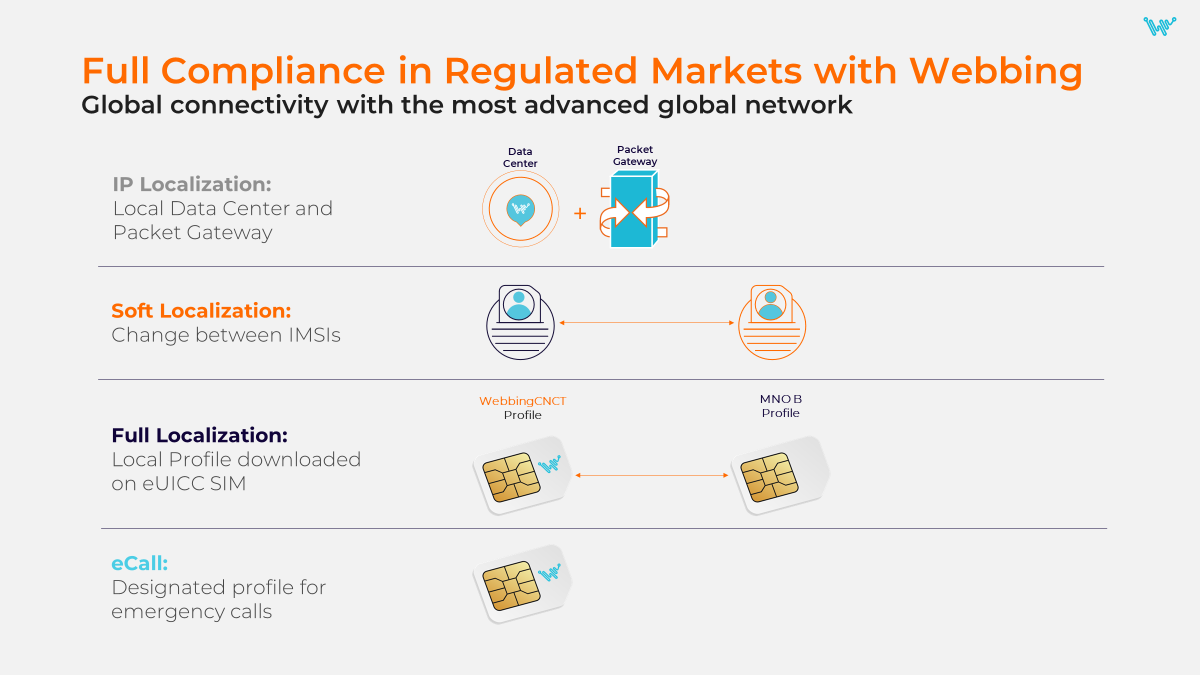Local regulation challenges enterprises can face – and how to overcome them.
by Yoram Zerahia
Cellular networks are often the most scalable and accessible solution for IoT connectivity, since there are cellular infrastructures all over the world. However, many countries have already enacted legislation on permanent roaming, data sovereignty, and data localization that might impact any cross-border IoT deployment that relies on cellular connectivity.

Connectivity regulations and restrictions
If mobile devices need to stay connected outside of their home network, they use a service called roaming. This service enables the device to connect to the network of any other carrier that has a roaming agreement with the device’s home mobile operator. It is very useful for IoT devices – not only because they may be deployed in any country or moved anywhere, but also because a roaming device can make use of more than one network, while a domestic device is usually limited to its home network. Having an option to use multiple networks ensures better connectivity and coverage.
Most mobile operators have roaming agreements that were originally designed for user devices that roam temporarily for a short time – a business trip or a vacation. If a device stays out of its home network for a longer time, typically over 3-4 months, it is considered “permanently roaming”.
In some countries permanent roaming is prohibited. Others effectively ban it by requiring the connectivity to be provided by a locally registered operator. Some governments permit permanent roaming, but IoT regulations are always subject to change. Even if permanent roaming is not officially banned by the government, local mobile operators may actually block it.
Governments may also enforce restrictions on how and where data is stored. Today, 71% of countries have data privacy laws and another 9% have legislation pending. Data sovereignty and data localization rules define how data should be collected and processed. These regulatory statutes can cause significant problems for IoT devices, especially when it comes to cross-border data requests.

How regulations affect IoT deployments and become a problem
Roaming restrictions potentially affect any enterprise that uses cellular networks to connect its IoT devices in multiple countries. Even though only 2% of IoT devices with cellular connection roam regularly, while 48% never move to other countries (ATMs, elevators or smart meters) and 50% potentially can roam but have a certain home market (like connected cars or smart watches), up to 50% of cellular IoT connections might be connected using roaming as it is the simplest way to get global coverage (Transforma Insights, 2021). This is due to the fact that mobile network operators frequently use roaming to connect devices on other operator networks.
Unless an enterprise complies with local regulations, after a certain period its roaming IoT devices may be disconnected without any warning. If, for example, a device deployed to the Middle East from Europe is supposed to receive important updates on its functionality over a cellular network, blocked connectivity might have a significant impact on their business. Moreover, there will be additional charges and hassle of reconnection, which may even require replacing SIM.
Depending on regulations there are four main types of requirements for IoT deployments that use cellular connectivity:

IP Localization
This type of localization requires a local data center for internet breakout. A packet gateway that sends and receives data to/from IoT devices also needs to be deployed locally to avoid traffic being controlled and signaling traffic being transmitted from a foreign country.
Soft Localization
This type of localization demands that a device has an International Mobile Subscriber Identity (IMSI) from a local carrier to be able to use cellular services permanently. An IMSI is a unique number used by an operator to identify the subscriber on its mobile network. This local IMSI may come from a global provider that has a roaming agreement with a local operator, and it can be managed on a foreign core network.
Full Localization
This type of localization requires a local SIM profile, and the connectivity services should be provided and managed by a local carrier. Technically, this means that an enterprise should have an agreement with at least one local operator in each country it plans to deploy IoT devices to or even several local network operators to make sure that coverage is sufficient. There also may be an issue with the management of connected IoT devices.
e-Call
This type of regulation is specific to the automotive industry. e-Call is an automatic call generated from a sensor inside the vehicle in case of a serious road accident. The call is made to the nearest emergency-response network, and it includes the data on coordinates and time of the accident to help the rescue services. Depending on the location it may require a local profile on a foreign eSIM. e-Call is mandatory in EU, Turkey, UAE, South Korea and Russia, while Saudi Arabia plans to enact necessary legislation by 2025.
There are also other challenges that enterprises may face when deploying IoT devices globally and they too need to be considered within the context of regulation compliance.
Multiple SKUs
OEMs usually ship the same products to various countries. But the restrictions on connectivity might force them to have multiple production lines to make different versions of the same product utilizing different carrier SIMs, which increases the cost of manufacturing, supply and logistics.
Future-proof
Regulations are always subject to change, which might affect businesses in the future. Back in 2020, when Turkish Information Technologies and Communication Authority required localization of data storage and eSIMs, major automotive OEMs could not import cars that already had foreign eSIMs and had to shut down e-call services so they would not fall under noncompliance with the regulation.
Latency
When devices are roaming, a foreign network typically sends the data to their home network. If data has to be transported across multiple countries to a home operator datacenter before it goes further to its destination, the latency increases significantly, which can create complications and even safety issues in certain industries such as automotive and healthcare.
SIM Management
Another complexity is managing the SIMs that allow IoT devices to connect to the cellular network. This may be especially challenging when the devices fleet amounts to thousands of units and it’s virtually impossible to manage the SIMs individually.
Is there one solution to all these problems?
While roaming is the most effective way to provide global connectivity for IoT devices, it may be a challenge to find one connectivity solution that would solve all of the problems mentioned above. The transition from SIM to eSIM and the upcoming new IoT eSIM standard from the GSMA (SGP.32) might help some solutions to address the problems of profile localization and multiple SKUs, but they can’t ensure low latency or global coverage, nor provide a centralized way to manage SIMs.
Webbing offers a solution that tackles all these problems.

Our core network allows for compliance with all local regulations and provides low latency due to its distributed infrastructure. Webbing’s solutions enable roaming on over 600 mobile network operators all over the world, which guarantees streamlined, continuous connectivity and global coverage.
Our pre-standard eSIM solution allows for remote provisioning and a swap between profiles without carrier integration, easily turning it into any operator’s SIM. It is fully aligned with the upcoming GSMA SGP.32 specification and will support the future IoT eSIM standard.
Webbing also offers a portal to manage eSIMs throughout their lifecycle. It allows for defining business rules that govern the automatic profile swap process and provides visibility to profile usage and network events.
The solution ensures compliance with all types of connectivity regulations, from keeping IP traffic inside the country to remote, over-the-air full localization. It enables enterprises to overcome the connectivity restrictions challenge in a simple and seamless way, avoiding the hassle of contracting with local wireless carriers and reducing the overhead expenses, making global IoT deployments fast, cost-effective and future ready.
Reach out to [email protected] to learn more about Webbing solutions.




